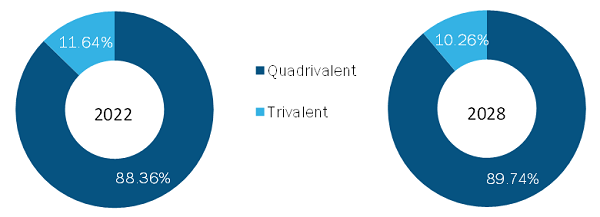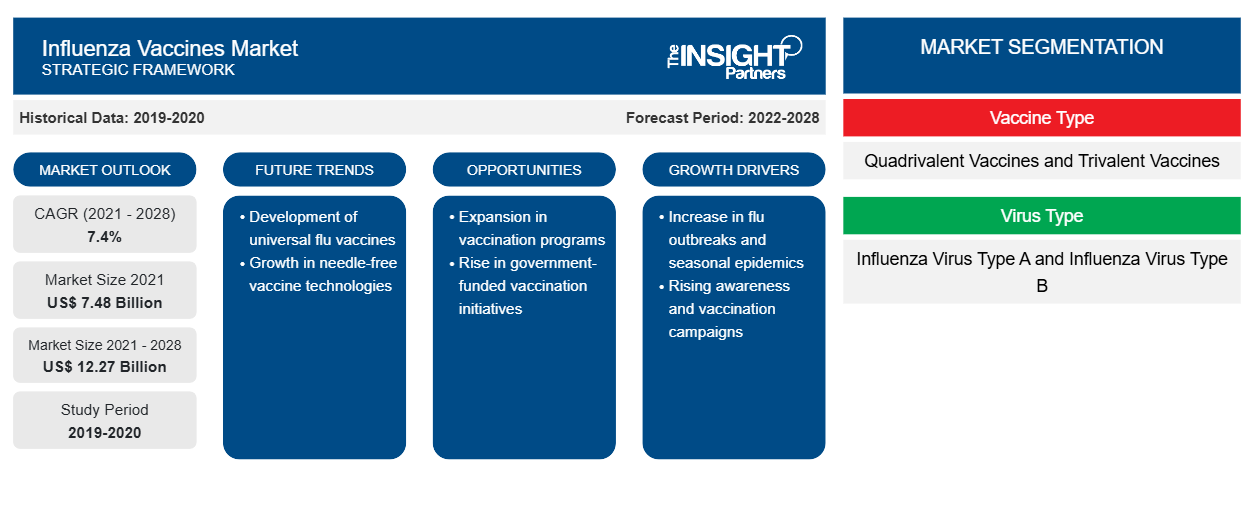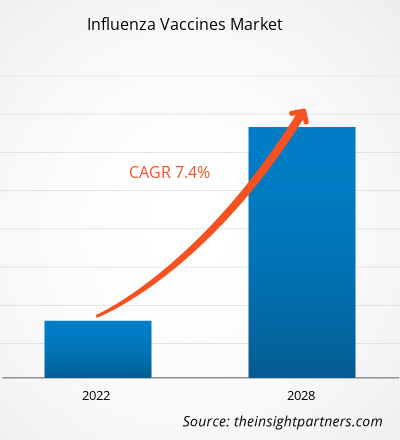Der Markt für Grippeimpfstoffe wurde im Jahr 2021 auf 7.478,53 Millionen US-Dollar geschätzt und soll bis 2028 auf 12.272,49 Millionen US-Dollar wachsen; mit einer durchschnittlichen jährlichen Wachstumsrate von 7,4 % von 2022 bis 2028.
Influenza ist eine ansteckende Atemwegsinfektion, die durch das Grippevirus verursacht wird. Influenza macht sich durch Fieber, Husten, Muskel- und Gelenkschmerzen, Kopfschmerzen und starke Schwäche bemerkbar. Die Krankheitsverläufe aufgrund von Influenza variieren von leicht bis schwer und führen manchmal zum Tod. Laut der Weltgesundheitsorganisation (WHO) beträgt die Zahl der Krankenhauseinweisungen aufgrund von Influenza im Jahr 2018 zwischen 3 und 5 Millionen Fälle schwerer Krankheitsverläufe, während die Zahl der Todesfälle aufgrund von Influenza zwischen 290.000 und 650.000 liegt. Zur Vorbeugung von Influenzainfektionen werden Impfstoffe empfohlen. Die schnelle Ausbreitung von Influenzavirusepidemien weltweit treibt die Nachfrage nach der Entwicklung eines wirksamen Influenzaimpfstoffs voran. Eine starke Produktpipeline ist ein Schlüsselfaktor, der das Marktwachstum im Prognosezeitraum vorantreibt.
Der Markt für Grippeimpfstoffe wird anhand von Impfstofftyp, Virustyp, Technologie, Verabreichungsweg, Zielgruppe und Geografie analysiert. Geografisch ist der Markt grob in Nordamerika, Europa, Asien-Pazifik, den Nahen Osten und Afrika sowie Süd- und Mittelamerika unterteilt. Der Marktbericht für Grippeimpfstoffe bietet Einblicke und eine eingehende Analyse des Marktes und betont Markttrends, technologische Fortschritte, Marktdynamik und die Wettbewerbsanalyse der führenden Marktteilnehmer.
Passen Sie diesen Bericht Ihren Anforderungen an
Sie erhalten kostenlos individuelle Anpassungen an jedem Bericht, einschließlich Teilen dieses Berichts oder einer Analyse auf Länderebene, eines Excel-Datenpakets sowie tolle Angebote und Rabatte für Start-ups und Universitäten.
- Holen Sie sich die wichtigsten Markttrends aus diesem Bericht.Dieses KOSTENLOSE Beispiel umfasst eine Datenanalyse von Markttrends bis hin zu Schätzungen und Prognosen.
Lukrative Regionen für den Markt für Grippeimpfstoffe
- Dieses KOSTENLOSE Beispiel umfasst eine Datenanalyse von Markttrends bis hin zu Schätzungen und Prognosen.
Markteinblicke
Steigende Investitionen führender Marktteilnehmer und Regierungen kurbeln den Markt für Grippeimpfstoffe an
Marktteilnehmer und Regierungen weltweit erhöhen ihre Investitionen in die Impfstoffentwicklung und Immunisierung. So kündigte Sanofi im März 2021 Investitionen in Höhe von rund 925 Millionen US-Dollar in eine neue Impfstoffproduktionsanlage an seinem bestehenden Standort in Toronto und Kanada an. Investitionen in die neue Anlage werden zusätzliche Antigen- und Abfüllkapazitäten für Sanofis hochdosierte quadrivalente Grippeimpfstoffe FLUZONE schaffen und die Verfügbarkeit in Kanada, den USA und Europa in den kommenden Jahren erhöhen.
- Im April 2021 unterstützten drei Regierungsebenen – Bund, Provinz und Kommunen – Sanofi Pasteur beim Bau einer „End-to-End“-Fabrik für Grippeimpfstoffe in Toronto. Die Partner werden fast 1 Milliarde US-Dollar investieren, um den Standort 2027 in Betrieb zu nehmen. Das in Paris ansässige Unternehmen Sanofi wird seinerseits mehr als 55 Millionen US-Dollar investieren, 165 neue förderfähige Arbeitsplätze schaffen und weitere 1.100 erhalten. Die Bundesregierung investiert 55 Millionen US-Dollar, während die Regierung von Ontario 55 Millionen US-Dollar beisteuert, was das Projekt auf 925 Millionen US-Dollar beläuft. Darüber hinaus wird Sanofi über einen Zeitraum von 8 Jahren jährlich mindestens 79 Millionen US-Dollar investieren, um Forschung und Entwicklung in Kanada zu finanzieren.
- Im November 2020 plante der Impfstoffhersteller Seqirus, 800 Millionen US-Dollar in ein bedeutendes australisches Impfstoffproduktionszentrum zu investieren. Die neue Anlage werde in Tullamarine im Geschäftsviertel des Melbourner Flughafens liegen und voraussichtlich 2026 in Betrieb gehen, sagte Seqirus. Die gewünschte Quadratmeterfläche gab das Unternehmen in einer Erklärung nicht bekannt.
- Im März 2022 kündigte die australische Regierung eine Investition von 100 Millionen US-Dollar in einen saisonalen Grippeimpfstoff an. Ziel dieser Investition ist es, Menschen vor Grippe und COVID-19 zu schützen und die Auswirkungen auf das australische Gesundheitswesen zu minimieren.
- Im Juni 2021 unterzeichnete die Europäische Investitionsbank mit dem Biotech-Unternehmen Univercells einen weltweiten Impfstoffvertriebsvertrag über 30,55 Millionen US-Dollar zur Massenproduktion des COVID-19-Impfstoffs an einem neuen belgischen Standort. Sie half beim Bau weiterer Impfstofffabriken auf der ganzen Welt. Im April 2022 gewährte die Bank dem italienischen biomedizinischen Forschungsunternehmen IRBM ein Darlehen über 15,27 Millionen US-Dollar, um seine Impfstoffproduktionskapazität zu erweitern und die Forschung zu Coronaviren und anderen Krankheiten zu intensivieren.
Somit stärkt die Steigerung der Investitionen führender Marktteilnehmer und Regierungen weltweit den Markt für Grippeimpfstoffe.
Erkenntnisse zum Impfstofftyp
Basierend auf dem Impfstofftyp ist der globale Markt für Grippeimpfstoffe in quadrivalente Impfstoffe und trivalente Impfstoffe unterteilt. Das quadrivalente Segment hatte im Jahr 2021 einen größeren Marktanteil. Es wird erwartet, dass dasselbe Segment im Prognosezeitraum schneller wächst. Die zunehmenden Produktzulassungen und Produkteinführungen zur Markterweiterung gehören zu den Haupttreibern des Wachstums des quadrivalenten Impfstoffsegments.
Markt für Grippeimpfstoffe nach Impfstofftyp – im Zeitraum 2022–2028


- Dieses KOSTENLOSE Beispiel umfasst eine Datenanalyse von Markttrends bis hin zu Schätzungen und Prognosen.
Einblicke in Virentypen
Basierend auf dem Virustyp ist der globale Markt für Grippeimpfstoffe in Grippeviren Typ A und Grippeviren Typ B unterteilt. Das Segment Grippeviren Typ A hatte 2021 einen größeren Marktanteil. Aufgrund der zunehmenden Verbreitung von Grippe Typ A wird erwartet, dass dieser Anteil im Prognosezeitraum schneller wächst. Das Marktwachstum des Segments Grippeviren Typ A wird darauf zurückgeführt, dass es die häufigste Form der Grippe ist. Es kann Tiere infizieren, obwohl mit dieser Art von Grippe verbundene Krankheiten häufiger sind.
Produktzulassungen und Kooperationen sind bei den Marktteilnehmern für Grippeimpfstoffe weit verbreitete Strategien. Nachfolgend sind einige der jüngsten wichtigen Marktentwicklungen aufgeführt:
- Im Juli 2022 genehmigte die US-amerikanische Food and Drug Administration (FDA) Sanofis Zulassungsantrag für Impfstoffe für die kommende Grippesaison 2022–2023, darunter Fluzone High-Dose Quadrivalent (Grippeimpfstoff), Flublok Quadrivalent (Grippeimpfstoff) und Fluzone Quadrivalent (Grippeimpfstoff). Diese Zulassung folgt auf die bevorzugte Empfehlung des Advisory Committee on Immunization Practices (ACIP) der CDC für Erwachsene ab 65 Jahren, darunter Fluzone High-Dose Quadrivalent und Flublok Quadrivalent.
- Im Juli 2022 gab GSK eine Vereinbarung mit der kanadischen Regierung über Impfstoffe gegen Pandemien und saisonale Grippe bekannt, um kanadische Erwachsene und Kinder zu schützen. Die vierjährige Vereinbarung, die bis März 2026 läuft, umfasst die Lieferung von bis zu 80 Millionen Dosen Arepanrix (adjuvantierter Pandemie-Grippeimpfstoff) im Falle einer Grippepandemie(n) und mindestens 4 Millionen Dosen Flulaval Tetra (saisonaler Grippeimpfstoff) pro Jahr.
Die COVID-19-Pandemie dürfte das Wachstum des weltweiten Marktes für Grippeimpfstoffe ankurbeln, da die Nachfrage nach Grippeimpfstoffen während einer Pandemie steigt. Laut Daten, die im November 2021 von den Centers for Disease Control and Prevention veröffentlicht wurden, stieg die Gesamtverabreichung von Grippeimpfstoffen in den USA von September bis Dezember 2020 um 9,0 %, wobei Jugendlichen und Erwachsenen mehr Dosen verabreicht wurden als von September bis Dezember 2018 und 2019.
Grippeimpfstoffe – Marktsegmentierung
Der globale Markt für Grippeimpfstoffe wird anhand von Impfstofftyp, Virustyp, Technologie, Verabreichungsweg, Zielgruppe und Geografie analysiert. Basierend auf dem Impfstofftyp wird der Markt in quadrivalente Impfstoffe und trivalente Impfstoffe segmentiert. Basierend auf dem Virustyp wird der Markt in Grippevirus Typ A und Grippevirus Typ B segmentiert. Basierend auf der Technologie wird der Markt in eibasierte und zellbasierte Impfstoffe unterteilt. Basierend auf dem Verabreichungsweg wird der Markt in Injektion und Nasenspray segmentiert. Basierend auf der Zielgruppe kann der Markt in Säuglinge, Kinder, Erwachsene und ältere Menschen segmentiert werden. Geografisch wird der Markt für Grippeimpfstoffe in Nordamerika, Europa, Asien-Pazifik, den Nahen Osten und Afrika sowie Süd- und Mittelamerika segmentiert.
Firmenprofile
Moderna, Inc.; SEQIRUS; Sanofi; GlaxoSmithKline plc; Hualan Biological Engineering Inc.; Emergent BioSolutions Inc.; Mitsubishi Chemical Group Corporation; Serum Institute of India Pvt. Ltd; Mylan NV; und AstraZeneca sind die wichtigsten Unternehmen auf dem Markt für Grippeimpfstoffe. Die Unternehmen verfolgen Produktinnovationsstrategien, um den sich weltweit entwickelnden Kundenanforderungen gerecht zu werden und so ihren Markennamen auf dem globalen Markt für Grippeimpfstoffe zu behaupten.
Umfang des Berichts zu Grippeimpfstoffen
| Berichtsattribut | Details |
|---|---|
| Marktgröße im Jahr 2021 | 7,48 Milliarden US-Dollar |
| Marktgröße bis 2028 | 12,27 Milliarden US-Dollar |
| Globale CAGR (2021 - 2028) | 7,4 % |
| Historische Daten | 2019-2020 |
| Prognosezeitraum | 2022–2028 |
| Abgedeckte Segmente | Nach Impfstofftyp
|
| Abgedeckte Regionen und Länder | Nordamerika
|
| Marktführer und wichtige Unternehmensprofile |
|
- Historische Analyse (2 Jahre), Basisjahr, Prognose (7 Jahre) mit CAGR
- PEST- und SWOT-Analyse
- Marktgröße Wert/Volumen – Global, Regional, Land
- Branche und Wettbewerbsumfeld
- Excel-Datensatz



Report Coverage
Revenue forecast, Company Analysis, Industry landscape, Growth factors, and Trends

Segment Covered
This text is related
to segments covered.

Regional Scope
North America, Europe, Asia Pacific, Middle East & Africa, South & Central America

Country Scope
This text is related
to country scope.
Häufig gestellte Fragen
The quadrivalent segment held the larger share of the market in the global influenza vaccines market contributing a market share of 88.36% in 2022.
The Asia Pacific is expected to be the fastest-growing region in the influenza vaccines market over the forecast period due to growing investments from international players in China and India, increasing disposable income, and influenza cases in these regions will show promising growth in the influenza vaccines market.
The influenza vaccines market is estimated to be valued at US$ 7,478.53 million in 2021.
The influenza vaccines market is expected to be valued at US$ 12,272.49 million in 2028.
The CAGR value of the influenza vaccines market during the forecasted period of 2022-2028 is 7.4%.
The influenza vaccines market majorly consists of the players, such as Moderna, Inc.; SEQIRUS; Sanofi; GlasoSmithKline plc; Hualan Biological Engineering Inc.; Emergent Biosolutions Inc.; Mitsubishi Chemical Group Corporation; Serum Institute of India Pvt. Ltd; Mylan N. V.; and AstraZeneca
The factors that are driving the growth of the influenza vaccines market are increase in government support to promote influenza vaccination and increasing investment by top market players and governments.
Influenza virus causes flu which is a contagious respiratory illness that infects nose, throat and lungs. It can mild or severe and sometimes may lead to death. Flu vaccination every year can help in preventing flu. However, this can be deadly, especially in high-risk groups. Aged population, pregnant women and people with one or more chronic disease or with weak immune systems are at high risk. Influenza vaccines/flu shots protect against the four influenza viruses’ subtypes that are most common. Most of the influenza vaccines are “flu shots†given with a needle, usually in the arm, but nasal spray flu vaccine are also available.
Trends and growth analysis reports related to Life Sciences : READ MORE..
The List of Companies - Influenza Vaccines Market
- Moderna, Inc.
- SEQIRUS
- Sanofi
- GlaxoSmithKline plc.
- Hualan Biological Engineering Inc.
- Emergent BioSolutions Inc.
- Mitsubishi Chemical Group Corporation
- Serum Institute of India Pvt. Ltd
- MYLAN N.V.
- AstraZeneca
The Insight Partners performs research in 4 major stages: Data Collection & Secondary Research, Primary Research, Data Analysis and Data Triangulation & Final Review.
- Data Collection and Secondary Research:
As a market research and consulting firm operating from a decade, we have published and advised several client across the globe. First step for any study will start with an assessment of currently available data and insights from existing reports. Further, historical and current market information is collected from Investor Presentations, Annual Reports, SEC Filings, etc., and other information related to company’s performance and market positioning are gathered from Paid Databases (Factiva, Hoovers, and Reuters) and various other publications available in public domain.
Several associations trade associates, technical forums, institutes, societies and organization are accessed to gain technical as well as market related insights through their publications such as research papers, blogs and press releases related to the studies are referred to get cues about the market. Further, white papers, journals, magazines, and other news articles published in last 3 years are scrutinized and analyzed to understand the current market trends.
- Primary Research:
The primarily interview analysis comprise of data obtained from industry participants interview and answers to survey questions gathered by in-house primary team.
For primary research, interviews are conducted with industry experts/CEOs/Marketing Managers/VPs/Subject Matter Experts from both demand and supply side to get a 360-degree view of the market. The primary team conducts several interviews based on the complexity of the markets to understand the various market trends and dynamics which makes research more credible and precise.
A typical research interview fulfils the following functions:
- Provides first-hand information on the market size, market trends, growth trends, competitive landscape, and outlook
- Validates and strengthens in-house secondary research findings
- Develops the analysis team’s expertise and market understanding
Primary research involves email interactions and telephone interviews for each market, category, segment, and sub-segment across geographies. The participants who typically take part in such a process include, but are not limited to:
- Industry participants: VPs, business development managers, market intelligence managers and national sales managers
- Outside experts: Valuation experts, research analysts and key opinion leaders specializing in the electronics and semiconductor industry.
Below is the breakup of our primary respondents by company, designation, and region:

Once we receive the confirmation from primary research sources or primary respondents, we finalize the base year market estimation and forecast the data as per the macroeconomic and microeconomic factors assessed during data collection.
- Data Analysis:
Once data is validated through both secondary as well as primary respondents, we finalize the market estimations by hypothesis formulation and factor analysis at regional and country level.
- Macro-Economic Factor Analysis:
We analyse macroeconomic indicators such the gross domestic product (GDP), increase in the demand for goods and services across industries, technological advancement, regional economic growth, governmental policies, the influence of COVID-19, PEST analysis, and other aspects. This analysis aids in setting benchmarks for various nations/regions and approximating market splits. Additionally, the general trend of the aforementioned components aid in determining the market's development possibilities.
- Country Level Data:
Various factors that are especially aligned to the country are taken into account to determine the market size for a certain area and country, including the presence of vendors, such as headquarters and offices, the country's GDP, demand patterns, and industry growth. To comprehend the market dynamics for the nation, a number of growth variables, inhibitors, application areas, and current market trends are researched. The aforementioned elements aid in determining the country's overall market's growth potential.
- Company Profile:
The “Table of Contents” is formulated by listing and analyzing more than 25 - 30 companies operating in the market ecosystem across geographies. However, we profile only 10 companies as a standard practice in our syndicate reports. These 10 companies comprise leading, emerging, and regional players. Nonetheless, our analysis is not restricted to the 10 listed companies, we also analyze other companies present in the market to develop a holistic view and understand the prevailing trends. The “Company Profiles” section in the report covers key facts, business description, products & services, financial information, SWOT analysis, and key developments. The financial information presented is extracted from the annual reports and official documents of the publicly listed companies. Upon collecting the information for the sections of respective companies, we verify them via various primary sources and then compile the data in respective company profiles. The company level information helps us in deriving the base number as well as in forecasting the market size.
- Developing Base Number:
Aggregation of sales statistics (2020-2022) and macro-economic factor, and other secondary and primary research insights are utilized to arrive at base number and related market shares for 2022. The data gaps are identified in this step and relevant market data is analyzed, collected from paid primary interviews or databases. On finalizing the base year market size, forecasts are developed on the basis of macro-economic, industry and market growth factors and company level analysis.
- Data Triangulation and Final Review:
The market findings and base year market size calculations are validated from supply as well as demand side. Demand side validations are based on macro-economic factor analysis and benchmarks for respective regions and countries. In case of supply side validations, revenues of major companies are estimated (in case not available) based on industry benchmark, approximate number of employees, product portfolio, and primary interviews revenues are gathered. Further revenue from target product/service segment is assessed to avoid overshooting of market statistics. In case of heavy deviations between supply and demand side values, all thes steps are repeated to achieve synchronization.
We follow an iterative model, wherein we share our research findings with Subject Matter Experts (SME’s) and Key Opinion Leaders (KOLs) until consensus view of the market is not formulated – this model negates any drastic deviation in the opinions of experts. Only validated and universally acceptable research findings are quoted in our reports.
We have important check points that we use to validate our research findings – which we call – data triangulation, where we validate the information, we generate from secondary sources with primary interviews and then we re-validate with our internal data bases and Subject matter experts. This comprehensive model enables us to deliver high quality, reliable data in shortest possible time.


 Holen Sie sich ein kostenloses Muster für diesen Bericht
Holen Sie sich ein kostenloses Muster für diesen Bericht